|
|
Post by instaforexgertrude on Feb 23, 2018 0:17:17 GMT -5
ECB report disappointed tradersThe European currency remained under pressure in tandem with the US dollar after the release of a weak report on the business climate in Germany. The traders were also not optimistic about the report of the European Central Bank on monetary policy. According to the Ifo Institute, the German business climate index declined for the month of January this year. This was due to the fact that the expectations of the companies in the manufacturing sector deteriorated for the next six months. Thus, the business sentiment index in February fell to 115.4 points from 117.6 points in January, while economists had expected the index to reach 117 points for the month of February. Despite this, the market reaction was rather restrained, as many traders were also confident that it would be difficult to surpass the positive sentiment in the German economy observed at the beginning of the year. The additional problems for exporters as reflected in the mood index, created a strong euro, as well as volatile capital markets. 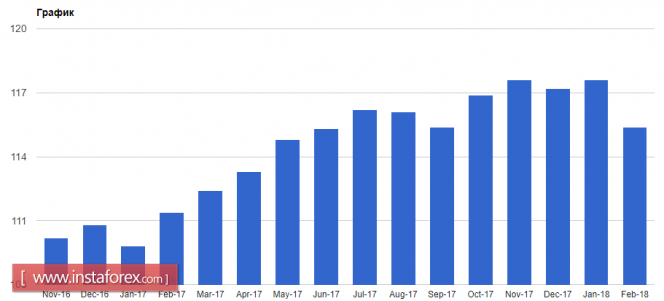 The publication of the minutes from the last meeting of the European Central Bank put pressure on the European currency because many traders and investors did not find the necessary signals from the regulator in connection with the end of the bond redemption program, which is expected to be completed this fall. Thus, the leaders of the ECB considered the inflation to still be too low as discussed in their January meeting. This suggests that it is too early to change monetary policy. As for the technical picture of the EURUSD pair, there have been no significant changes compared to the morning forecast. Still, you can expect to form an upward correction towards the end of the week, which may start from the support levels of 1.2260 and 1.2240 in the short term. However, there is no need to exclude today's possibility of sellers updating to a larger support area of 1.2210, where large players will also announce themselves. The British pound negatively reacted to the UK GDP report and fell in the morning against the US dollar. According to the data, the UK economy in the fourth quarter of 2017 grew weaker than expected. The report of the National Bureau of Statistics indicates that the UK GDP in the fourth quarter grew only by 0.4% against a preliminary estimate of 0.5%. On an annualized basis, GDP growth in the fourth quarter was revised downward to 1.6% from 2.0%. For the entire 2017, the UK's GDP grew by 1.7%. The main problem for the government remains to be the Brexit, which continues to affect many sectors of the economy. Analysis are provided byInstaForex.
|
|
|
|
Post by instaforexgertrude on Feb 27, 2018 1:31:24 GMT -5
Elliott wave analysis of EUR/NZD for February 27, 2018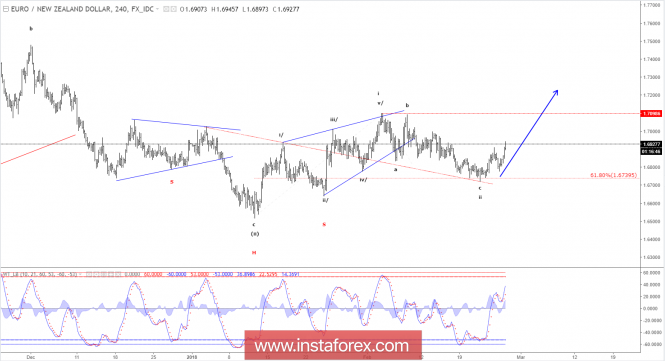 Wave summary: EUR/NZD has rallied nicely and is headed towards the first more substantial resistance near 1.7100. Once this resistance is cleared, the way higher to 1.7470 and 1.7777 is open. Support is now seen at 1.6850, and the important support is seen at 1.6780. R3: 1.7094 R2: 1.6990 R1: 1.6937 Pivot: 1.6887 S1: 1.6850 S2: 1.6780 S3: 1.6723 Trading recommendation: We are long EUR from 1.6790, and we will move our stop higher to 1.6775. Analysis are provided byInstaForex.
|
|
|
|
Post by instaforexgertrude on Feb 27, 2018 23:51:53 GMT -5
Data on the US economy supported the US dollar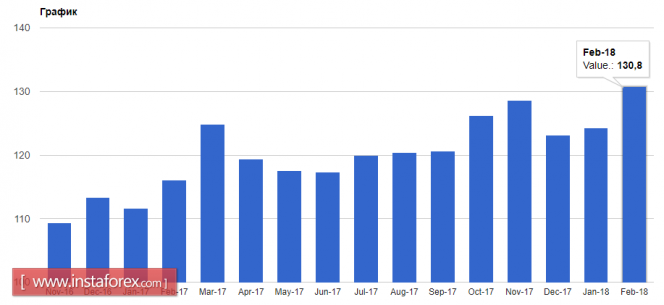 Data on inflation in Germany did not affect the quotations of the European currency, as attention was solely focused on the speech of the chairman of the Federal Reserve. According to the statistics agency, Germany's preliminary consumer price index rose 0.5% in February from January, while the index grew 1.4% compared to the same period in 2017. These data almost completely coincided with the expectations of experts who projected an increase of 0.5% and 1.5% respectively. The base index, which does not take into account the volatile categories of goods, also increased by 0.5% in February and by 1.2% compared to February 2017. Given the fact that the data was in line with economists' forecasts, recent statements by ECB representatives that the stance of monetary policy will remain unchanged, along with the confirmation of such intent by the president of the central bank, Mario Draghi, it speaks of the weak prospects for the growth of the euro in the early spring of this year . The data pointing to a drop in demand for goods with a long service life, passed for investors without a trace. According to the report of the US Department of Commerce, orders for durable goods in January this year decreased by 3.7% compared with the previous month. Economists had expected the decline to be 1.6%. As noted in the report, the main drop was mainly due to a 10% decrease in orders for transportation equipment. New orders for capital goods fell by 0.2%. The fall of this indicator is the first "call" that consumers are starting to save more. Housing prices in the US in December of last year continued to grow. This report was presented by CoreLogic/Case-Shiller. Thus, the national housing price index in December grew by 6.3% compared to the same period last year. As experts say, the current sharp rise in prices already exceeds the growth of salaries in the US, which can affect inflation this year and slow it down a little. Good data on consumer confidence in the US only supported the US dollar, which began its rapid growth after the speech of the new head of the Fed, Jerome Powell. According to the Conference Board, the consumer confidence index in February this year reached 130.8 points against 124.3 points in January. Economists had expected the index in February to be 127.0 points. The report also indicates that the volatility of the stock market did not affect consumers who showed higher optimism about short-term prospects. Analysis are provided byInstaForex.
|
|
|
|
Post by instaforexgertrude on Feb 28, 2018 23:12:17 GMT -5
Inflation in the euro area declines for the third consecutive monthAll the attention of traders was focused on the data on inflation in the euro area which disappointed market participants. Inflation in the euro area is declining for the third consecutive month. What can we expect from the euro? No matter how it seems, the inflation rate that was set in the autumn of last year is gradually extinguished with the euro zone's CPI is declining for the third consecutive month. This is a very unpleasant fact for the European Central Bank which set a 2% target in the next few years. This is also an unpleasant moment for traders who are betting on the further strengthening of the euro at the beginning of this year. The main reason for the lack of demand is the probable postponement of the deadline for the curtailment of the ECB's repurchase program, which was scheduled for the fall of this year. Also, we have to forget about all the talk about raising interest rates in early 2019. Let's understand why it happened that way. According to today's data, even if it is preliminary, it can be seen that in February this year, the inflation rate in the eurozone slowed for the third month in a row. So, consumer prices in the euro area for the month of February rose by only 1.2% compared to the same period in 2017, which is below the target level of the ECB, set just below 2%. As early as November 2017, inflation showed an increase of 1.5%. 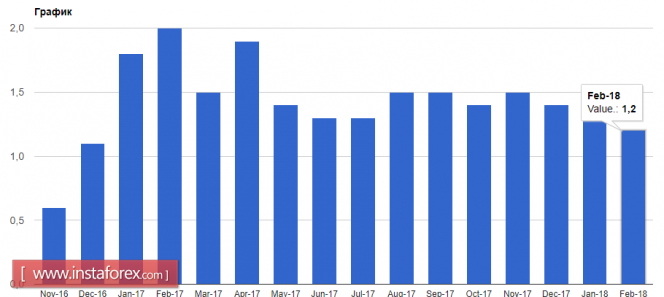 A number of experts associate a slowdown in inflation with a decline in energy prices, which revived the CPI in 2016 and kept it growing throughout 2017. Also, there is a noticeable lack of a fundamental link between the acceleration of economic growth and the rise in inflation that was to occur. A similar situation is observed in the United States. If we talk about core inflation, which does not take into account volatile prices for energy and food products, then growth was at 1%. As I have already mentioned, a number of European Central Bank leaders, including its president Mario Draghi, made it clear that as long as there is no concrete evidence of an increase in inflation, no one will talk about a change in soft monetary policy despite good economic growth. It is important to note that the strong growth of the US dollar began yesterday after Federal Reserve Chairman Jerome Powell made a speech in the Congress where he said that there was an improvement in the prospects for the US economy, which keeps the Federal Reserve's policy rigid. So he outlined his position on further raising interest rates. As for the technical picture of the EURUSD pair, the breakthrough in the support level of 1.2200 could significantly collapse the trading instrument, since there is a mass of monthly stop orders for buyers of risky assets below this range. The breakthrough at the level of 1.2200 will lead to a pair of support in the areas of 1.2130 and 1.2080, which will also allow us to hook the level of 1.2050. Analysis are provided byInstaForex.
|
|
|
|
Post by IFX Yvonne on Mar 5, 2018 3:31:16 GMT -5
Daily analysis of EUR/JPY for March 5, 2018 EUR/JPY This cross pair is a weak market. It is interesting to see the market is engaged in a long, protracted bearish movement. Since the beginning of February, at least, 700 pups have been shed. In the past few weeks, short-term rallies have been invariably followed by further southwards movements.  There is currently a Bearish Confirmation Pattern in the market. The price would continue moving downwards towards the demand zones at 130.00, 129.50 and 129.00. Nonetheless, a strong rally is in the offing, as the outlook on EUR pairs is bullish for this week. *The market analysis posted here is meant to increase your awareness, but not to give instructions to make a trade.
|
|
|
|
Post by instaforexgertrude on Mar 6, 2018 0:51:53 GMT -5
USD/JPY approaching resistance, prepare to sell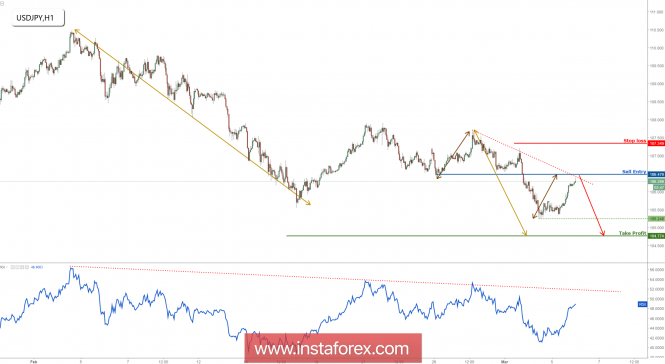 The price is seeing strong resistance at 106.47 (Fibonacci retracement, Fibonacci extension, horizontal overlap resistance, descending resistance) and a strong reaction could occur at this price to push it down to 104.77 support (Fibonacci extension). We do have to watch out for intermediate support at 105.24 (horizontal swing low support) which needs to be broken to open a further drop. RSI (89) sees descending resistance hold price down really well with its bearish momentum. Sell below 106.47. Stop loss at 107.34. Take profit at 104.77. Analysis are provided byInstaForex.
|
|
|
|
Post by instaforexgertrude on Mar 8, 2018 0:26:07 GMT -5
Gold was trappedThe news about the resignation of the chief economic adviser to the president Gary Cohn allowed gold to mark its best daily level since Valentine's Day. If an ardent opponent of protectionism, an ex-candidate for the presidency of the Fed, withdraws from his post, a potential global trade war is unlikely to be avoided. And in it, all weapons will look good. Including - large-scale selling of US Treasury bonds by the main holders in the face of China and Japan. I believe other countries will do the same. Their desire to get rid of the power of the dollar will force them to shift to gold. Thus, trade wars are potentially capable of providing the precious metal with invaluable support. Until March, investors' demand for ETF products was characterized by mixed dynamics. The fall in the XAU/USD and the increase in gold volatility contributed to an outflow of 5.1 tonnes in February. The biggest losses were suffered by European (-7.3 tons) and North American stock-exchange specialized funds (-5.1 tons), while Asians, on the contrary, replenished their reserves (+7.9 tons). As a result, according to the latest figure, it has increased by 10% since the beginning of the year. Monthly dynamics of demand for ETF products 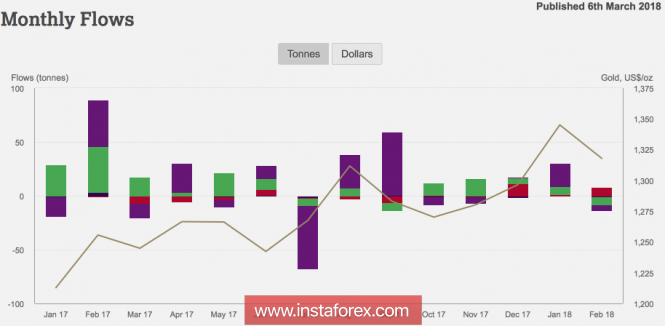 Source: WGC. Annual dynamics of demand for ETF products 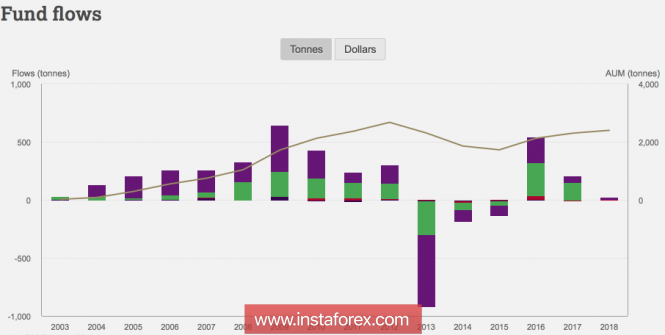 Source: WGC. In my opinion, the value of the investment demand for precious metals was influenced by the strengthening of the US dollar. The fastest growth in the weekly wage in January over the past few years has strengthened the risks of overclocking inflation and the aggressive monetary tightening of the Fed. Moreover, the new head of the Federal Reserve was optimistic about the US economy and the way of betting on federal funds. The President of the Federal Reserve Bank of New York, William Dudley, indicated four hikes in 2018 - a gradual normalization of monetary policy. As a result, the futures market increased the chances of such an outcome to 34%, and gold plunged into a wave of selling. Everyone remembers perfectly how uncomfortable it felt at the eve of the historic FOMC meetings in 2017. Nevertheless, the growing likelihood of the implementation of the policy of anti-globalization, Donald Trump, significantly tempered investors' appetite for risk. If the stock indexes behaved rather restrained in response to the high-sounding statements of the US president on tariffs on the import of steel and aluminum, the resignation of Gary Cohn convinced that the matter should be taken very seriously. In the medium term, gold can be trapped in consolidation: on the one hand, news about the trade war will provide support to the bulls on the XAU/USD; on the other hand, the return of the divergence idea in the monetary policy of the Federal Reserve and the central banks-peers can become a saving straw for the US dollar. In my opinion, in the second and third quarters, against the background of the return of the normalization theme, its strength will run out, so the price will drop to the lower border of the trading range of $1300-1360 per ounce, which makes sense to use for purchases. Technically, if the bulls manage to return gold quotes to the limits of the upward medium-term trading channel, then the risks of implementing the target values by 113% and by 127.2% according to the Shark and AB = CD patterns will increase. Gold, daily chart  Analysis are provided byInstaForex. Analysis are provided byInstaForex.
|
|
|
|
Post by instaforexgertrude on Mar 9, 2018 1:54:30 GMT -5
Technical analysis of EUR/USD for March 09, 2018 When the European market opens, some economic data will be released such as the French Industrial Production m/m, the French Gov Budget Balance, the German Trade Balance, and the German Industrial Production m/m. Meanwhile, the US will also deliver some reports such as the Final Wholesale Inventories m/m, the Unemployment Rate, the Non-Farm Employment Change, and the Average Hourly Earnings m/m. So amid the reports, EUR/USD will move in a medium to high volatility during this day. TODAY'S TECHNICAL LEVELS: Breakout BUY Level: 1.2369. Strong Resistance:1.2362. Original Resistance: 1.2350. Inner Sell Area: 1.2338. Target Inner Area: 1.2309. Inner Buy Area: 1.2280. Original Support: 1.2268. Strong Support: 1.2256. Breakout SELL Level: 1.2249. Analysis are provided byInstaForex.
|
|
|
|
Post by instaforexgertrude on Mar 12, 2018 1:20:24 GMT -5
USD/JPY has reached our profit target perfectly, prepare for further rise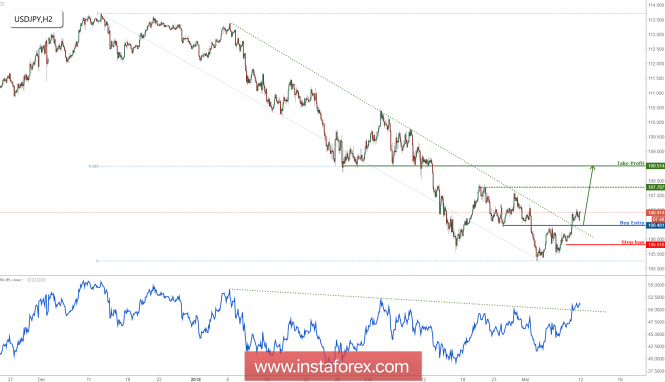 The price has risen perfectly to our profit target and looks poised to rise further after breaking a strong descending resistance-turned-support line. We look to buy above 106.48 (Fibonacci retracement, horizontal overlap support, breakout level) for a push up to 108.51 (Fibonacci retracement, horizontal pullback resistance). We do have to be cautious about 107.78 resistance as the price might react off that level. RSI (89) has made a similar bullish exit signaling a change in momentum from bearish to bullish. Buy above 106.48. Stop loss at 105.81. Take profit at 108.51 Analysis are provided byInstaForex.
|
|
|
|
Post by IFX Yvonne on Mar 20, 2018 5:47:34 GMT -5
NZD/USD Intraday technical levels and trading recommendations for for March 20, 2018 Daily Outlook In July 2017, an atypical Head and Shoulders pattern was expressed on the depicted chart which indicated upcoming bearish reversal. As expected, the price level of 0.7050 failed to offer enough bullish support for the NZD/USD pair. That's why, further bearish decline was expected towards 0.6800 (Reversal pattern bearish target). Evident signs of bullish recovery was expressed around the depicted low (0.6780). An inverted Head and Shoulders pattern was expressed around these price levels. The price zone of 0.7140-0.7250 (prominent Supply-Zone) failed to pause the ongoing bullish momentum. Instead, a bullish breakout above 0.7250 was expressed on January 11. That's why, a quick bullish movement was expected towards the depicted supply zone (0.7320-0.7390) where evident bearish rejection and a valid SELL entry were expected. On February 2, a bearish engulfing daily candlestick was expressed off the price level of 0.7390. Moreover, a double-top reversal pattern was expressed around the price zone (0.7320-0.7390). The price zone (0.7320-0.7390) stood as a significant supply zone for the NZD/USD pair. Any bullish pullback towards this price zone should be considered for a valid SELL entry. On the other hand, bearish breakdown of 0.7300 (neckline) is needed to confirm the depicted reversal pattern. Bearish projection target would be located around 0.7050 and 0.7000. *The market analysis posted here is meant to increase your awareness, but not to give instructions to make a trade.
|
|
|
|
Post by IFX Yvonne on Mar 21, 2018 5:31:16 GMT -5
EUR/JPY analysis for March 21, 2018 ![]() forex-images.ifxdb.com/userfiles/20180321/analytics5ab2265520a5a.png forex-images.ifxdb.com/userfiles/20180321/analytics5ab2265520a5a.png [/img] Recently, the EUR/JPY pair has been trading sideways at the price of 130.48. According to the 30M time frame, I found that price has broken the upward channel (bearish pennant) in the background, which is a sign that buying looks risky. I also found a strong downward leg in the background, which is another sign of weakness. My advice is to watch for potential selling opportunities. Downward targets are set at the price of 130.32 and at the price of 129.60. Resistance levels: R1: 131.30 R2: 132.20 R3: 132.65 Support levels: S1: 129.93 S2: 129.44 S3: 128.53 Trading recommendations for today: watch for potential selling opportunities. *The market analysis posted here is meant to increase your awareness, but not to give instructions to make a trade.
|
|
|
|
Post by instaforexgertrude on Mar 23, 2018 0:33:00 GMT -5
Daily analysis of EUR/JPY for March 23, 2018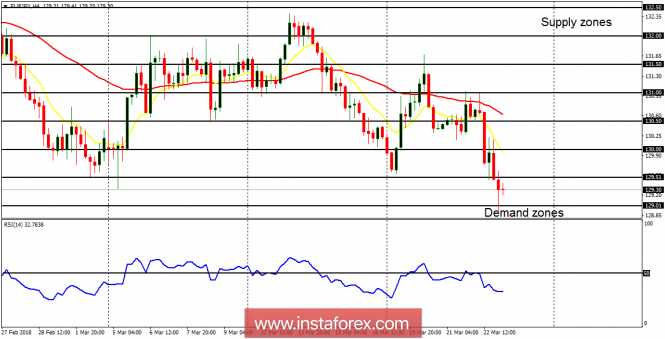 EUR/JPY The long-awaited bearish bias has already surfaced on this cross. The price plunged yesterday, breaching the supply zone at 129.50 to the downside. The demand zone at 129.00 was tested before the price bounced upwards (temporarily). The demand zone at 129.00 would be tested once again, and get broken to the downside, as the market moves further downwards. There is a Bearish Confirmation Pattern in the market, and it has become clearer as price goes further downwards owing to a bearish outlook on the cross. The EMA 11 is below the EMA 56, and the RSI period 14 is below the level 50. Analysis are provided byInstaForex.
|
|
|
|
Post by instaforexgertrude on Mar 26, 2018 1:23:01 GMT -5
Daily analysis of EUR/JPY for March 26, 2018EUR/JPY The conditions in the market is quite choppy. Although the market is choppy, the bearish trend has been maintained.Price has been going southward since February 5, having lost almost 800 pips since then. Last week, there was a rally attempt in the context of an uptrend, which was halted once the supply zone at 131.50 had been tested. 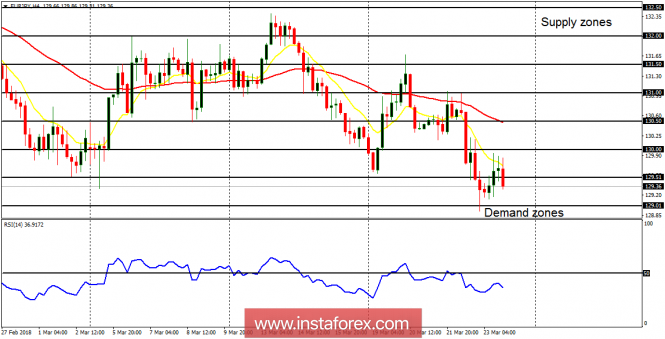 Further upward movement was effectively prevented. The market shed 250 pips following that, to test the demand zone at 129.00, and closed below the supply zone at 129.50. The expected weakness in EUR, as well as the bearish outlook on the market, may enable the demand zones at 129.00, 128.50, and 128.00 to be tested this week. Analysis are provided byInstaForex.
|
|
|
|
Post by instaforexgertrude on Mar 27, 2018 0:20:16 GMT -5
Daily analysis of GBP/USD for March 27, 2018The pair stays strong in the short-term as the price action is consolidating above the support zone of 1.4136. Currently, GBP/USD is facing off the resistance level of 1.4225, which is the last hurdle ahead of the 1.4269 level and if it manages to break above such area, the bulls could strengthen in the short-term. MACD indicator remains in the positive territory, favoring to the bulls.  H1 chart's resistance levels: 1.4225 / 1.4269 H1 chart's support levels: 1.4136 / 1.4061 Trading recommendations for today: Based on the H1 chart, buy (long) orders only if the GBP/USD pair breaks a bullish candlestick; the resistance level is at 1.4225, take profit is at 1.4269 and stop loss is at 1.4185. Analysis are provided byInstaForex.
|
|
|
|
Post by IFX Yvonne on Mar 28, 2018 1:04:22 GMT -5
Technical analysis: Intraday level for USD/JPY, March 28, 2018 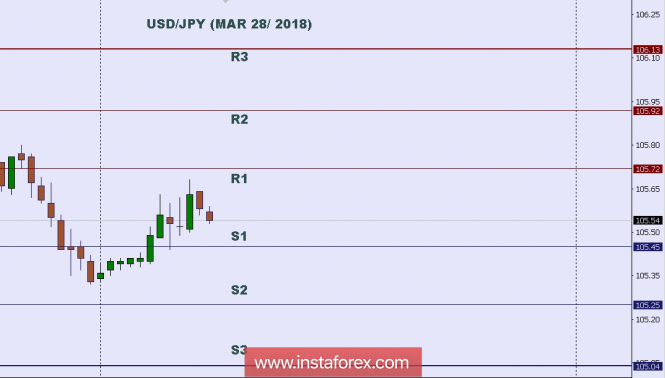 Today Japan will not release any Economic Data, but the US will release some Economic Data such as Crude Oil Inventories, Pending Home Sales m/m, Prelim Wholesale Inventories m/m, Goods Trade Balance, Final GDP Price Index q/q, and Final GDP q/q. So, there is a probability the USD/JPY will move with a low to medium volatility during this day. TODAY'S TECHNICAL LEVEL: Resistance. 3: 106.13. Resistance. 2: 105.92. Resistance. 1: 105.72. Support. 1: 105.45. Support. 2: 105.25. Support. 3: 105.04. Disclaimer: Trading Forex (foreign exchange) on margin carries a high level of risk, and may not be suitable for all Traders or Investors. The high degree of leverage can work against you as well as for you. Before deciding to invest in foreign exchange you should carefully consider your investment objectives, level of experience, and risk appetite. The possibility exists that you could sustain a loss of some or all of your initial investment and therefore you should not invest money that you cannot afford to lose. You should be aware of all the risks associated with foreign exchange trading, and seek advice from an independent financial advisor if you have any doubts. *The market analysis posted here is meant to increase your awareness, but not to give instructions to make a trade.
|
|

















